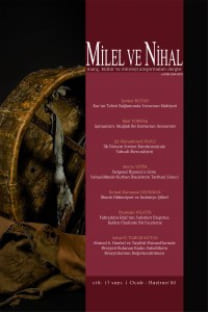Hz. Musa’nın Yüzleştiği Statüko: Kadim Mısır’ın Ma’at Doktrini
Hz. Musa firavun
ile karşılaştığında mücadele etmesi gereken en temel sorun, kadim Mısır
mitolojisinin ürettiği ma’at doktrini olmuştur. Kaos ve karmaşa
karşısından düzen ve uyumu koruyup sürdüren bu doktrin firavunlarının tanrısal
meşruiyet kaynağını ifade etmiştir. Mısır’ın erken dönemindeki politik
bölünmüşlük ve savaşların ardından sağlanan barış ortamı Set ve Horus olarak
iki farklı tanrısal unsur ile nitelenmiştir. Firavunlara huzur ve düzenin
sağlanması görevi Horus yetkisiyle sağlanmıştır. Böylece kadim Mısır’da
düzensizlik ve kaos korkusu üzerine inşa edilmiş güçlü bir ma’at doktrini
söz konusudur. Bu doktrin kurulu düzenleri korurken firavunları düzen ve
istikrardan sorumlu tanrısal unsur yani Horus olarak nitelemiştir. Hz. Musa’nın
firavun karşısında yüzleştiği en çetin direnç noktası binlerce yıllık mitolojik
temel üzerine oturmuş olan bu statükocu yapıdır.
The Status quo that Moses Faced: The Ma’at Doctrine of Ancient Egypt
The most basic problem that
Prophet Moses has to deal with, when he encountered Pharaoh is the ma’at doctrine that is produced Egyptian
mythology. This doctrine, which preserves the rule and order against to chaos
and disorder, had stated the divine legitimacy source of Pharaohs. The peace
situation had been provided after several wars and political division in early
Egyptian history. This setting was described with two different divine beings
as Seth and Horus. The Pharaohs were ensured via Horus power for providing
order and tranquility. So, there is a strong ma’at doctrine, which is established on disorder and chaos fear in
ancient Egypt. This doctrine protects the established orders and Pharaohs are
described as divine being, that is Horus, which is responsible for stability
and order. The stiff resistance that prophet Moses faced against Pharaoh is this
status quo, which resided on the thousands of year’s mythological basis.
___
- Ayad, Mariam F. “The Pre-Christian Period: Changing Times and Cultu-ral Endurance”, ed.: L. M. Farag, The Coptic Christian Heritage: His-tory, Faith and Culture (London: Routledge, 2014).
- Bell, Lanny. “The New Kingdom Divine Temple: The Example of Luxor”, Temples of Ancient Egypt, ed.: B. E. Shafer (New York: Cornell Uni-versity Press, 1997).
- Cannon-Brown, Willie. Nefer: The Aesthetic Ideal in Classical Egypt (New York: Routledge, 2006).
- Christensen, Wendy. Empire of Ancient Egypt (New York: Chelsea House, 2009).
- Cline, Eric H., Rubalcaba, J. The Ancient Egyptian World (Oxford: Oxford University Press, 2005).
- Dunand, Françoise. Zivie-Coche, Christiane. Gods and Men in Egypt: 3000 BCE to 395 CE, tr.: D. Lorton (London: Cornell University Press, 2004).
- Eliade, Mircea. Dinsel İnançlar ve Düşünceler Tarihi, çev.: A. Berktay (İstan-bul: Alfa, 2016).
- Hinds, Kathryn. The Pharaoh's Court (New York: Marshall Cavendish Benchmark, 2007).
- Hoffmeier, James K. Israel in Egypt: The Evidence for the Authenticity of the Exodus Tradition (Oxford: Oxford University Press, 1996).
- Kemp, Barry J. Ancient Egypt: Anatomy of a Civilization (London: Rotuledge, 2006).
- Kramer, Ann. Egyptian Myth: A Treasury of Legends, Art, and History (New York: Routledge, 2015).
- Lehman, Cynthia L. “The Kemetic Paradigm: An Afrocentric Foundation for Rhetorical Theory”, ed., V. H. Milhouse vd., Transcultural Rea-lities: Interdisciplinary Perspectives on Cross-Cultural Relations (Lon-don: Sage Publication, 2001).
- Meral, Yasin. Sâmirî’nin Buzağısı (Ankara: Ankara Okulu, 2018).
- Pinch, Geraldine. Egyptian Mythology: A Guide to the Gods, Goddesses, and Traditions of Ancient Egypt (Oxford: Oxford University Press, 2002).
- Tobin, Vincent Arieh. “Mytho-Theology in Ancient Egypt”, Journal of the American Research Center in Egypt, vol. 25 (1988).
- Tyldesley, Joyce. Penguin Book of Myths And Legends of Ancient Egypt (Lon-don: Penguin Books, 2010).
- Wilkinson, Toby. Eski Mısır: MÖ 3000’den Kleopatra’ya Bir Uygarlığın Tarihi, çev.: Ü. H. Yolsal (İstanbul: Say, 2016).
- Wilson, John A. The Culture of Ancient Egypt (Chicago: Chicago Univer-sity Press, 1951).
- ISSN: 1304-5482
- Yayın Aralığı: Yılda 2 Sayı
- Başlangıç: 2003
- Yayıncı: Milel ve Nihal: Eğitim, Kültür ve Düşünce Platformu Derneği
Sayıdaki Diğer Makaleler
Son Muhalifin İzinde: Yeryüzünün Son “Göksel Muhalifi” Hz. Muhammed (sav)
Muhalefet, Kime ve Neye: Dinsel Söylemde Muhalefet
Hz. Peygamber Döneminde Düşünce Özgürlüğü ve Muhalefet
Geleneğin Tahripkâr Gücünün Yansımaları: Baskı, Susturma ve Unutulmuşluk
Hz. Musa’nın Yüzleştiği Statüko: Kadim Mısır’ın Ma’at Doktrini
Bir Zâhidin Örnek Muhalefeti: Hasan Basrî
